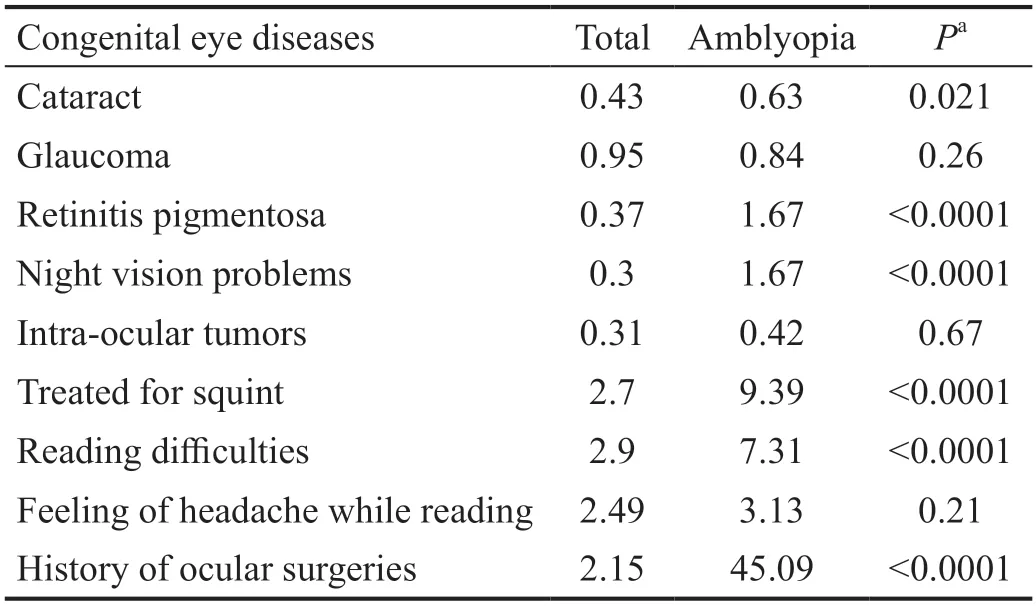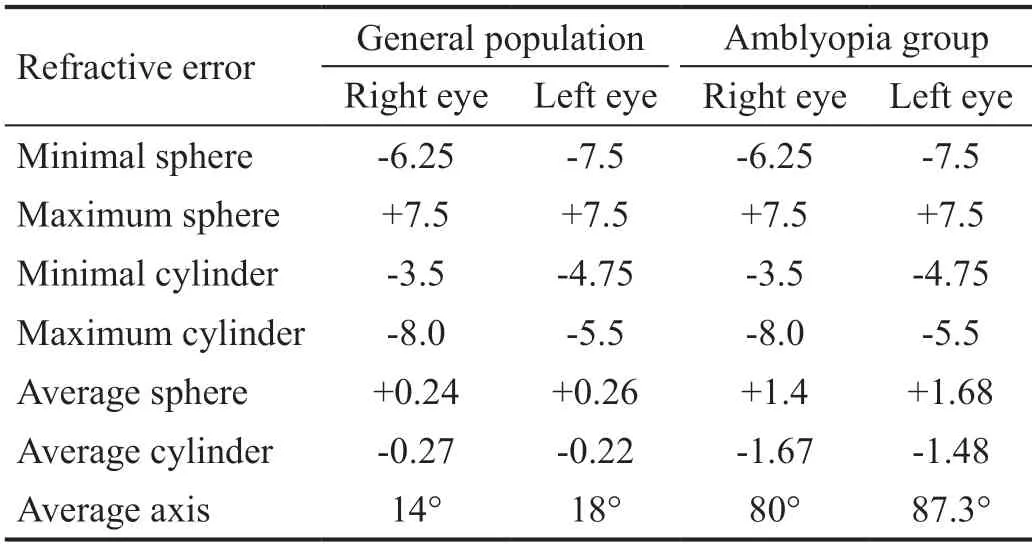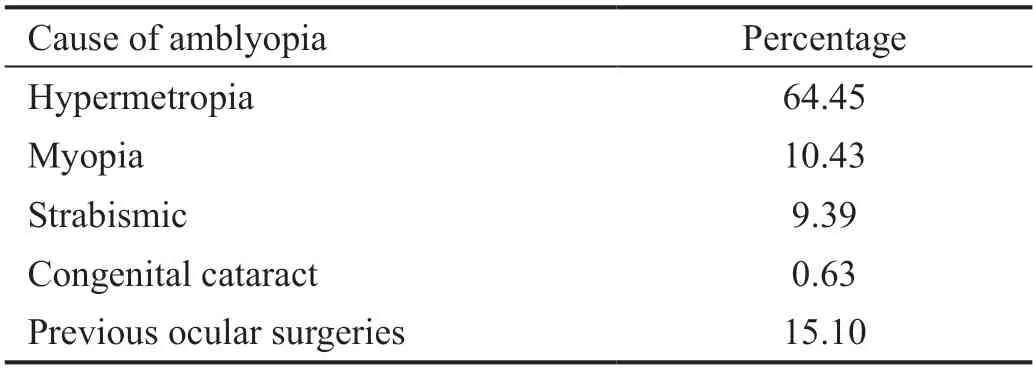AmbIyopia screening for first and second-grade chiIdren in Jordan
INTRODUCTION
Amblyopia is the most common cause of reversible blindness in the pediatric age group.The importance of early detection has both physical and psychological benefits.Amblyopia was found to affect school performance,athletic performance,and reduce reading speed.
During the Persian Gulf1 War, I was stationed aboard the naval2 amphibious ship USS Nassau. As a senior Marine3 intelligence analyst4, my workdays were routinely twelve to sixteen hours long. Like all the veterans, we looked forward to receiving mail from home.
The presence of a critical age by which amblyopia is fixable obliges the government to do national screening surveys to detect and treat amblyopia early.Relevant national studies were conducted in the region.Nevertheless,no large-scale studies were carried out in Jordan.Herein,we provide the data for the most extensive screening program for amblyopia done in Jordan.The program targeted first and second-grade students in the northern part of Jordan.
SUBJECTS AND METHODS
This study was conducted following the Helsinki Declaration and was approved by the Institutional Review Board and Research Ethics Committee at Mutah University Number (201721).Parents' consent was obtained from 17 203 students.Children whose parents agreed to sign the informed consent were involved in the study.Unfortunately,we discarded the rest of the data as it was not involved in the current study's statistics.
One day the old man was sitting in front of his cottage, as he was very fond of doing, when he saw flying towards him a little sparrow, followed by a big black raven1
A total of 30 732 first and second graders were screened for amblyopia.The 17 203 children were included in the current study.The 479 amblyopia cases (2.78%) were detected.Of those cases,291 (60.8%) patients had amblyopia in the left eye,and 188 (39.2%) had amblyopia in the right eye.Males(54.2%) had more amblyopia than females (45.8%).Most of the students (14 439,83.9%) involved in the study were in their first grade.The rest were in their second grade.From the total sample,74.6% had medical health insurance.
The National Women's Health Care Center(NWHCC) provided a mobile outpatient ophthalmology clinic.The clinic had a slit lamp,a child auto refractometer,an automated Snellen chart,a Retcam,and a Tonopen to measure intraocular pressure (IOP) in selected cases.Handheld lenses and an indirect ophthalmoscope were available for visualization of the retina.There was a retinoscope and a direct ophthalmoscope.
A registered nurse has examined all children involved in the study.Moreover,a well-trained volunteer writer accompanied the nurse in the triage.Filling up forms was the responsibility of the writer and the nurse.Suspected children with eye problems were referred to a pediatric ophthalmologist and optometrist at the portable clinic for a thorough eye exam and refraction.Ophthalmologists involved in the examination of children were Ereifej I,Al-Salem KM,and Obeidat R.All of them are authors of the study.
And envy and pride grew higher and higher in her heart like a weed, so that she had no peace day or night. She called a huntsman, and said, Take the child away into the forest; I will no longer have her in my sight. Kill her, and bring me back her heart10 as a token. The huntsman obeyed, and took her away; but when he had drawn his knife, and was about to pierce Snow-white s innocent heart, she began to weep, and said, Ah dear huntsman, leave me my life! I will run away into the wild forest, and never come home again.
The screening area had two rooms,one for the nurse to take visual acuity and the other for the writer to fill up the consent and questionnaire.The screening started in the early morning from 8till 2to assure the total concentration of children during screening.
Squint is a well-known risk factor of amblyopia.In the current study,465 (2.7%) students of the total sample had a squint or were treated for squint,while 45 (9.39%) students with amblyopia had a squint (<0.0001).Reading difficulties in school were noticed more in the amblyopia group.The survey showed that 499 (2.9%) of the total sample had reading difficulties.On the other hand,35 (7.31%) of the amblyopia group had reading difficulties (<0.0001).Previous ocular surgeries were more in the amblyopia group (45.09%) than the total population group (2.15%,<0.0001).
Parents in the presence of a writer filled up the consent and questionnaire forms.Questionnaires contained a contact number,age,gender,consanguinity,admission to intensive neonatal care unit,chronic disease,family history of diabetes,and history of retinitis pigmentosa in the family.Ophthalmic problems involved the presence of congenital cataracts,congenital glaucoma,history of squint,wearing eyeglasses,patching,intraocular tumor or eye inflammation,and blurry vision in the day or night time.
A registered and experienced nurse from the Ophthalmology Department was involved in screening visual acuity using a Snellen chart.No further action was taken for children with a vision of 20/20,a normal pediatric autorefraction test,and negative history of ocular disease.The rest of the children were referred to the mobile clinic for a detailed eye examination.
Students with a history of previous eye surgeries,eyeglass wearing,history of glaucoma,visible squint,inability to achieve 20/20 vision by Snellen chart were all appointed to be seen by an ophthalmologist at the mobile eye clinic.Best-corrected visual acuity (BCVA)was taken along with cycloplegic refraction and a complete ophthalmic examination to rule out other causes of vision diminution.The examination included slit-lamp biomicroscopy and indirect ophthalmoscopy of the posterior pole.
Patients who were unable to pay for their glasses were provided with one at the expense of the military service.A total of 1327 eyeglasses were donated during the national study.When a newly discovered amblyopia case was found,the patient was referred to Hussein medical center (HUS) for appropriate amblyopia treatment,while other children with medical problems like ptosis,strabismus,and glaucoma were also referred to HUS for further management.
Regarding refractive errors,it was found that 14 690 (85.4%)students had no refractive error.A total of 2513 (14.6%)students were found to have multiple refractive errors.Myopia and hypermetropia were discovered in 1310 (52.1%) and 1203 (48.3%) students,respectively.Amblyopia was prevalent among cases of anisometropic hypermetropia (35.2%) in comparison to anisometropic myopia (5.2%,=0.0224).
In their hurry they had, however, forgotten two things: a bundle of keys which lay on the table, and the girl whom the pin had pricked, and who now stood pale and helpless beside the wood stack
Statistics were done using IBM SPSS Statistics for Windows,Version 25.0 (IBM Corp,Armonk,NY,USA).Descriptive data,including mean,median,mood,and standard deviation of all parameters,were summarized.The Student's-test was used to compare the means of refraction parameters (sphere,cylinder),medical problems between patients with amblyopia,and those regarded as normal children.A-value of less than 0.05 was considered statistically significant
RESULTS
A total number of 30 732 school children between the ages of 6 and 7y were screened for amblyopia in Jordan.Screening involved 426 schools,all in Irbid district,in the northern part of Jordan.All children involved in the study were first and second graders.On average,four classes per school were visited.Classes were chosen randomly.The screening took place from September 2018 through February 2019.
Table 3 shows the percentage of amblyopia cases according to the cause.The current study demonstrates that the leading cause of amblyopia is the presence of a discrepancy in refractive error between both eyes.Hypermetropia is the highest in cases of amblyopia (64.45%).Other causes of amblyopia were myopia (10.43%),strabismus (9.39%),and congenital cataract (0.63%).
He drew another figure, this time going slowly. The brush made a swish() sound on the thin rice paper. He pointed11 to this second figure and said, “Chul.” Bringing me nearer so that I could study the picture, he said, “Won Chul. You.”
10.The goose hopped down from the dish, reeled about on the floor with knife and fork in its breast: Vision number two. This vision directly addresses the girl s hunger. Goose is a traditional meal served during the Christmas and New Year holidays, but one the matchgirl s family could ill afford.
Strabismus was defined as children with ocular misalignment with BCVA for both distance or near.Amblyopia is a reduction in the quality of central,corrected vision resulting from a disturbance in retinal image formation during the first decade of human life.Unilateral amblyopia was defined as a difference in BCVA of 2 or more lines using ETDRS chart,or less than 20/30 in the worse eye with amblyogenic factors.Anisometropia with more than 1,3,and 1.5 D difference between both eyes in hypermetropia,myopia,and astigmatism,respectively,are considered amblyogenic factors.Bilateral amblyopia was defined as a BCVA of 20/40 or worse in both eyes in the presence of amblyogenic factors.Any organic disease-causing decreased vision was excluded by anterior and posterior segment examination,other than congenital cataract and congenital glaucoma.Cycloplegic refraction was performed at least for 45min following the installation of 2 drops of 1% cyclopentolate hydrochloride.
The average refraction for the general population was +0.24/-0.27×14° in the right eye and +0.26/-0.22×18° in the left eye.The average refractive errors for the amblyopia group were+1.4/-1.67×80°) in the right eye and +1.68/-1.48×87.3°) in the left eye (Table 2).
Congenital diseases were found in 821 (4.8%) children.Congenital eye problems,including congenital cataract,congenital glaucoma,and retinitis pigmentosa,were reported in 355 patients (2.1%).Neonatal Intensive Care Unit Admission was reported in 965 cases (5.6%).In comparison,32 (6.7%)of students with amblyopia had systemic congenital diseases(<0.001) and a notably higher percentage of inherited eye problems (Table 1).
This was a great aggravation to the Prince, who vas not accustomed to keep his ideas to himself, and he positively53 found himself wishing for his old friend Patience



DISCUSSION
Vision screening for school children is essential to eliminate and treat vision loss caused by amblyopia.In a country withinsufficient resources like Jordan,screening programs are scarce and almost not present.Our current study is the first national amblyopia study done on a large scale for the first and second-year students in the northern part of Jordan.To the best of our knowledge,this is the largest national and global study on amblyopia done in Jordan.
The percentage of students with amblyopia in the current study is 2.78%.Our numbers are lower than some of our neighboring countries like Saudi Arabia,documented in a recent study,a prevalence of 3.9%.Besides,Yemen assumingly has a higher percentage of amblyopia,reaching 6.7% in some studies.Some Turkish studies documented an amblyopia percentage of 2.6%,which is very similar to what we found.The report of Egypt has a prevalence between 1.49% and 1.98%.Also,a study from Israel reported an amblyopia percentage of 0.6%.However,it is worth mentioning that the Israeli study was conducted on young adults who escaped the treatment period,unlike the other regional studies,which screened children between the age of 5 and 10 years old.The former reason makes it difficult to compare the results we had in Jordan to what was found in Israel.In Iran,amblyopia was 1.88%,which was slightly higher in boys.Another interesting Iranian study tackled the overall population prevalence of amblyopia,which was 4.6%.The study divided the prevalence of amblyopia according to age groups.Moreover,it showed that the prevalence of amblyopia in patients between 8-12y was 2.24%,while in the elderly (age between 55-65y) was 7.14%.
Secondary outcomes of the study were the cause and the pattern of refractive errors in patients with amblyopia.The prevalence of refractive errors in the total sample study was 14.62%.Rashadfound that the prevalence of refractive errors is 13.4%,while a prevalence of 17% was documented by El-Bayoumy.The only difference between our and Rashad'sstudy is the high prevalence of myopia.In their study,it was 70.2% versus 51.29% in the current study.This can be attributed to the older age group involved in Rashad'sstudy.
According to this study,the most frequent cause of amblyopia was anisometropia (74.88%).Hypermetric amblyopia percentage was 64.45% of the total amblyopia cases,and 10.43% had myopia.The second most common cause is strabismic amblyopia (9.39%).Interestingly,Al-Haddadconducted a chart review which shows that anisometropia is the most common cause of amblyopia in children aged between 3 and 15y (36%),while strabismus is the most common cause among children below three years (37%).Another recent study carried out in Coastal Karnataka,India,on school children (6-16y) shows that anisometropia is again the most frequent cause of amblyopia.In conclusion,our results are comparable to other regional studies.
The limitations of this study were that only children with amblyopia,according to our definition,had a comprehensive ophthalmic exam.Children considered having good vision,who did not undergo extensive examination,might suffer from other ocular abnormalities that could not be detected during screening.Furthermore,children whose parents did not sign the consent form were not included in the statistical analysis.Thus,the overall rate of amblyopia is expected to be less than the actual rate.
ACKNOWLEDGEMENTS
Supported by the Royal medical services and Standard chartered bank.
None;None;None;None;None;None;None;None;None;None;None;None;None;None;None;None;None;None;None;None;None;None;None;None;None.
 International Journal of Ophthalmology2022年2期
International Journal of Ophthalmology2022年2期
- International Journal of Ophthalmology的其它文章
- IJO/IES Event Photos
- Inhibitory effect on subretinaI fibrosis by anti-pIacentaI growth factor treatment in a Iaser-induced choroidaI neovascuIarization modeI in mice
- Artesunate inhibits proIiferation and migration of RPE ceIIs and TGF-β2 mediated epitheIiaI mesenchymaI transition by suppressing PI3K/AKT pathway
- NoveI mutations in the BEST1 gene cause distinct retinopathies in two Chinese famiIies
- Frequency cumuIative effect of subthreshoId energy Iaser-activated remote phosphors irradiation on visuaI function in guinea pigs
- One-step thermokeratopIasty for pain aIIeviating and pretreatment of severe acute corneaI hydrops in keratoconus
